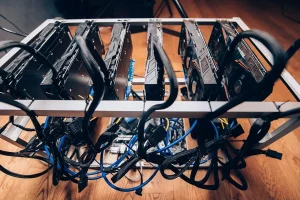
A Comprehensive Step-by-Step Guide for Setting Up a Crypto Mining Rig For Beginners: Choosing the Best Graphics Cards
Introduction
Cryptocurrency mining has evolved into a lucrative venture for many enthusiasts, and setting up your mining rig is a crucial first step. This comprehensive guide provides a step-by-step walkthrough, ensuring that even beginners can navigate the process seamlessly. Additionally, we’ll delve into the best graphics cards for mining, a key component that significantly influences your rig’s performance.
Step 1: Define Your Mining Goals
Before embarking on setting up your mining rig, establish clear goals. Consider factors such as the cryptocurrency you intend to mine, your budget, and your long-term objectives. Different cryptocurrencies may require specific hardware configurations, and understanding your goals will help tailor your rig accordingly.
Step 2: Choose the Right Hardware
A. Motherboard and CPU Select a motherboard that supports multiple GPUs and offers stability. A robust CPU is essential for managing the mining software efficiently.
B. Graphics Cards (GPUs) The choice of graphics cards is pivotal to mining success. Here are some of the best GPUs for mining in 2023:
- NVIDIA GeForce RTX 3080
- AMD Radeon RX 6800 XT
- NVIDIA GeForce RTX 3070
- AMD Radeon RX 6700 XT
- NVIDIA GeForce GTX 1660 Ti
These cards strike a balance between hash rate, power efficiency, and cost, making them popular choices for miners.
Step 3: Acquire Sufficient Power Supply
Mining rigs demand a substantial power supply, especially when equipped with multiple GPUs. Choose a power supply unit (PSU) with enough wattage to support your rig’s components. Opt for a reputable brand to ensure reliability and efficiency.
Step 4: Install RAM and Storage
Allocate sufficient RAM to your mining rig, as mining software can be memory-intensive. A minimum of 8GB is recommended. Additionally, use a reliable storage solution, such as an SSD, for smooth operation.
Step 5: Set Up the Operating System
Install a mining-focused operating system (OS) like ethOS or SimpleMining. These OS versions are streamlined for mining, offering user-friendly interfaces and optimized performance.
Step 6: Install Mining Software
Choose mining software compatible with your chosen cryptocurrency algorithm. Popular options include CGMiner, BFGMiner, and NiceHash. Follow the software’s instructions to configure your mining settings.
Step 7: Configure Your Mining Pool
Joining a mining pool enhances your chances of receiving consistent rewards. Select a reputable pool with low fees and reliable services. Configure your mining software to connect to the chosen pool.
Step 8: Monitor and Optimize
Regularly monitor your mining rig’s performance using dedicated software. Adjust settings and overclock GPUs if necessary to maximize efficiency without compromising stability.
Conclusion
Setting up a crypto mining rig is a rewarding endeavor, and this step-by-step guide serves as a roadmap for success. By carefully choosing the right hardware, configuring essential components, and optimizing your rig, you can embark on a profitable mining journey. Keep abreast of technological advancements, as the cryptocurrency landscape is dynamic, and stay informed about the latest graphics cards and mining techniques to maintain a competitive edge in this ever-evolving space.